A post examining common responses to the question of why the cost of housing continues to rise requires a frank discussion about the nature of Seattle's "housing shortage."

Michael Goldman asks a critical question, with relevance to other cities around the country, and eventually finds an answer that many pro-housing advocates might not like: "Why do Seattle rents continue to rise to higher and higher levels of unaffordability?"
Goldman notes a narrative that is used more and more frequently in the city to explain the lack of affordable housing: a housing shortage. "The housing shortage narrative has largely replaced the language of supply-and-demand, which has recently been criticized for being too reminiscent of trickle-down economics or too simplistic (although some still favor it)," writes Goldman.
The differences between the two lines of argument, Goldman writes, are subtle: "The essence of the shortage argument is the same as the supply-and-demand argument, though. Simply, when the production of housing outpaces the demand for housing we have a housing surplus. When housing production falls behind demand we have a housing shortage."
Thus, Goldman begins the process of debunking the housing shortage narrative, specifically the typical claim about the regulatory causes of the high cost of housing: "upon closer examination, the housing shortage between 2010 to 2015 was not the result of restrictive local regulations but restrictive global capital."
Goldman also suggests a new narrative that might actually be more tractable: out of control rents. The high cost of rent, according to Goldman, is a specific housing shortage that isn't resolved by simply building more housing. "To address the specific shortage, it’s time we started looking at specific solutions including a progressive income tax, rent stabilization, and aggressively capturing the value concentrating in urban land so it can be funneled into affordable housing."
FULL STORY: What Housing Shortage?

Alabama: Trump Terminates Settlements for Black Communities Harmed By Raw Sewage
Trump deemed the landmark civil rights agreement “illegal DEI and environmental justice policy.”

Planetizen Federal Action Tracker
A weekly monitor of how Trump’s orders and actions are impacting planners and planning in America.

The 120 Year Old Tiny Home Villages That Sheltered San Francisco’s Earthquake Refugees
More than a century ago, San Francisco mobilized to house thousands of residents displaced by the 1906 earthquake. Could their strategy offer a model for the present?

Ken Jennings Launches Transit Web Series
The Jeopardy champ wants you to ride public transit.

BLM To Rescind Public Lands Rule
The change will downgrade conservation, once again putting federal land at risk for mining and other extractive uses.

Indy Neighborhood Group Builds Temporary Multi-Use Path
Community members, aided in part by funding from the city, repurposed a vehicle lane to create a protected bike and pedestrian path for the summer season.
Urban Design for Planners 1: Software Tools
This six-course series explores essential urban design concepts using open source software and equips planners with the tools they need to participate fully in the urban design process.
Planning for Universal Design
Learn the tools for implementing Universal Design in planning regulations.
Clanton & Associates, Inc.
Jessamine County Fiscal Court
Institute for Housing and Urban Development Studies (IHS)
City of Grandview
Harvard GSD Executive Education
Toledo-Lucas County Plan Commissions
Salt Lake City
NYU Wagner Graduate School of Public Service





























